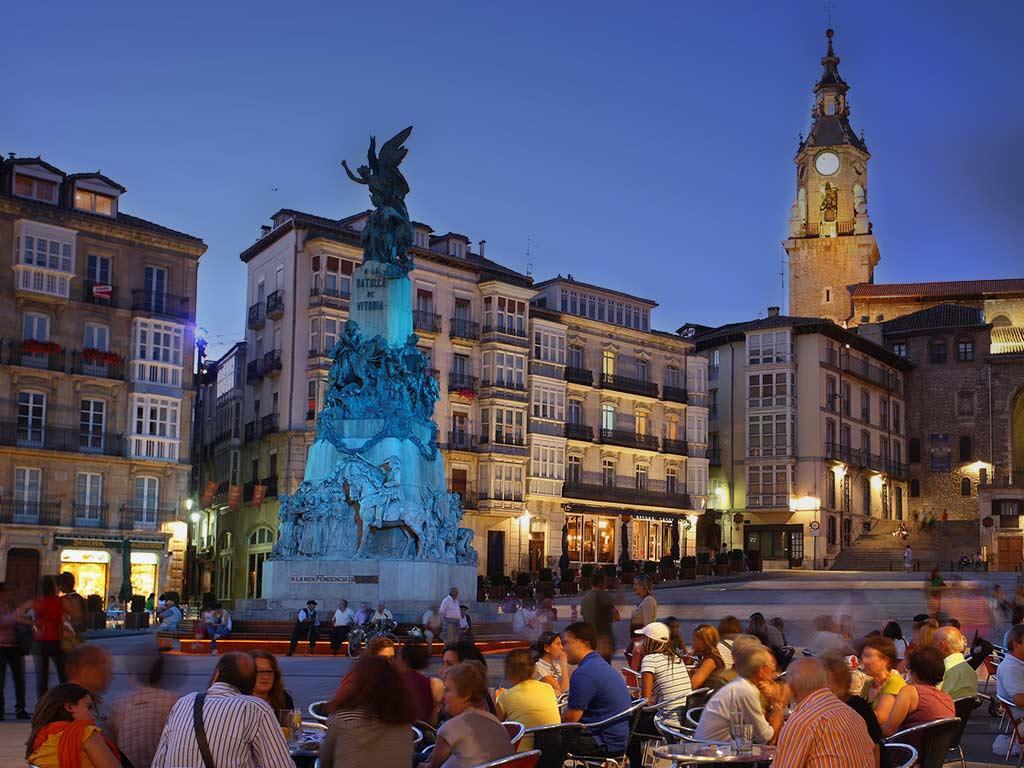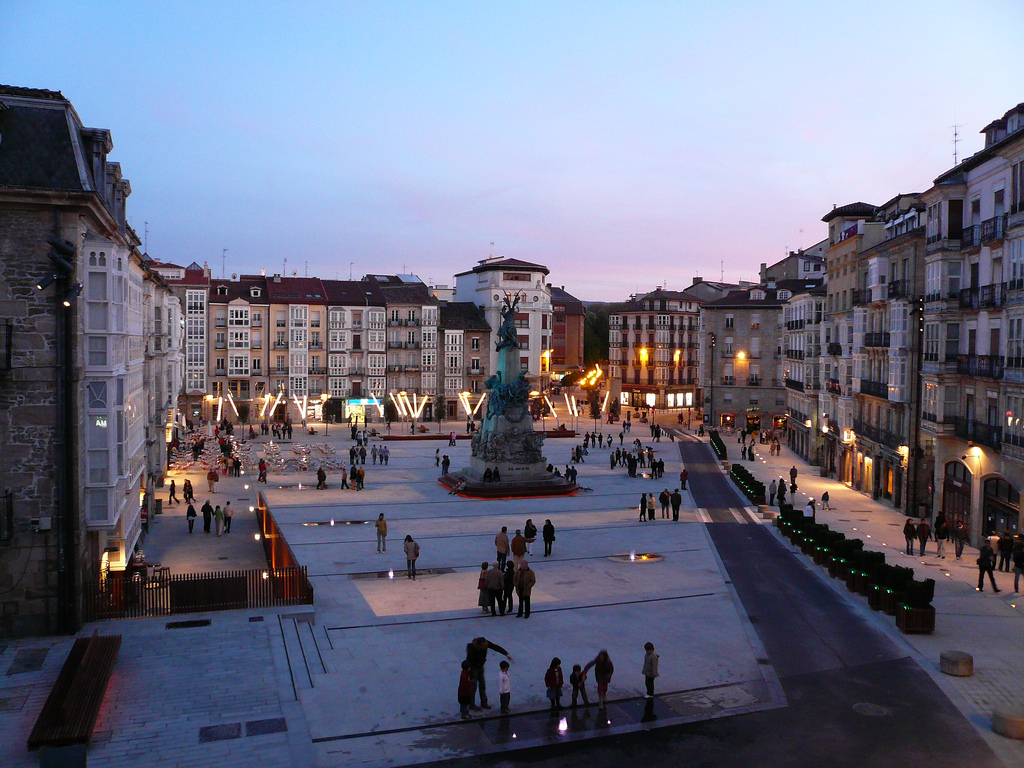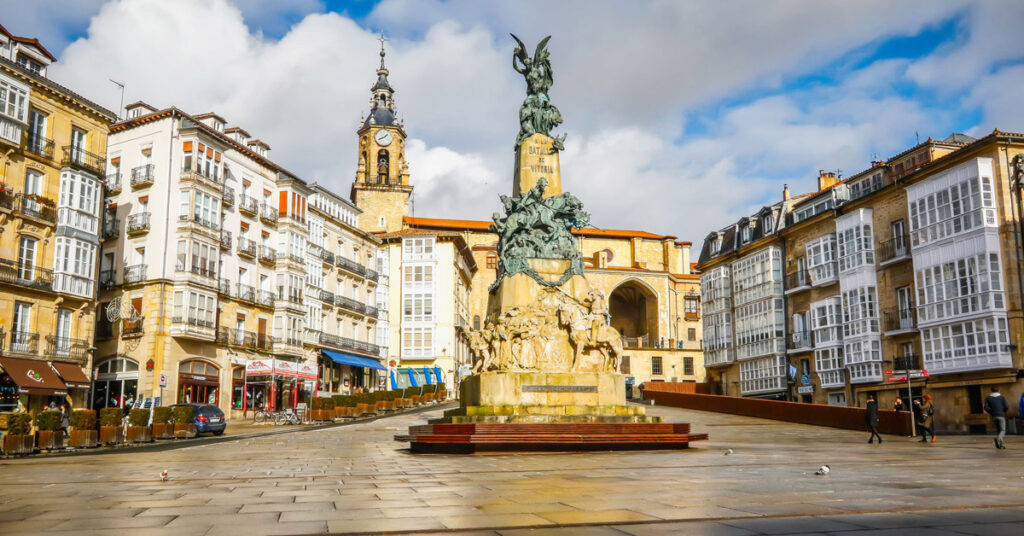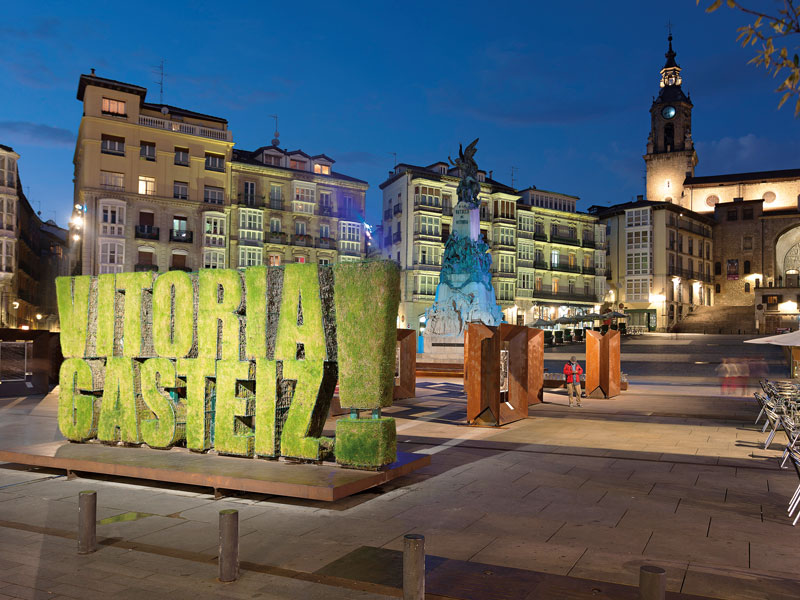Vitoria-Gasteiz is the seat of government and the capital city of the Basque Country and of the province of Araba/Álava in northern Spain. It holds the autonomous community’s House of Parliament, the headquarters of the Government, and the Lehendakari’s (Prime Minister’s) official residency. The municipality—which comprises not only the city but also the mainly agricultural lands of 63 villages around—is the largest in the Basque Country, with a total area of 276.81 square kilometres (106.88 sq mi), and it has a population of 252,571 (May 2019). The dwellers of Vitoria-Gasteiz are called vitorianos or gasteiztarrak, while traditionally they are dubbed babazorros (Basque for ‘bean sacks’).
Vitoria-Gasteiz is a multicultural city with strengths in healthcare, aeronautics, vehicle industry, and gastronomy. It is consistently ranked as one of the 5 best places to live in Spain, it is the first Spanish municipality to be awarded the title of European Green Capital (in 2012) and it has been also recognized by the UN with the Global Green City Award (in 2019). The old town has some of the best preserved medieval streets and plazas in the region and it is one of very few cities with two cathedrals. The city also holds well known festivals such as the Azkena rock festival, FesTVal, Vitoria-Gasteiz jazz festival, and the Virgen Blanca Festivities.
Vitoria-Gasteiz’s vicinity is home to world-renowned wineries such as Ysios (by Santiago Calatrava) and the Marqués de Riscal Hotel (by Frank Gehry); relevant heritage sites including the Neolithic remains of Aizkomendi [es], Sorginetxe and La chabola de la Hechicera; Iron Age remains such as the settlements of Lastra and Buradón; antique remains such as the settlement of La Hoya and the salt valley of Añana; and several medieval fortresses including the Tower of Mendoza and the Tower of Varona.
Beethoven dedicated his Opus 91, often called the “Battle of Vitoria” or “Wellington’s Victory“, to one of the most famous events of the Napoleonic Wars: the Battle of Vitoria, in which a Spanish, Portuguese and British army under the command of General the Duke of Wellington broke the French army and nearly captured the puppet king Joseph Bonaparte. It was a pivotal point in the Peninsular War, and a precursor to the expulsion of the French army from Spain. A memorial statue can be seen today in Virgen Blanca Square.
Attractions
- Cathedral of Santa Maria (Old Cathedral), a 14th-century Gothic building with a 17th-century tower. Under the pórtico are three open doorways decorated with statues and reliefs. In the interior, chapels containing Gothic, Flemish and Italian Renaissance images including paintings by Rubens and van Dyck. The cathedral is undergoing restoration and has been studied by experts from around the world for its architectural curiosities, including those deformations which it has suffered due to previous restorations.
- Cathedral of María Inmaculada of Vitoria (New Cathedral), built and consecrated in the 20th century, in Gothic revival style.
- Andre Maria Zuriaren plaza/Plaza de la Virgen Blanca. It is a square to which converge some of the most typical streets of the old town and the 19th-century city expansion and is surrounded by old houses with glass verandas. At its center stands a monument commemorating the Battle of Vitoria.
- Diocesan Museum of Sacred Art of Álava, located in Cathedral of María Inmaculada ambulatory, houses samples of religious art heritage of the province, divided into sections of stone carving, wood carving, painting on wood, paint on canvas, jewelry and furniture liturgical.
- Church of St. Peter the Apostle (14th century) in Gothic style. The Old Portico, with a set of reliefs depicting scenes from the lives of St. Peter and the Virgin Mary, run under the pictures of the Virgin and the apostles.
- Church of St. Michael the Archangel (14th–16th centuries), in Gothic-Renaissance style. Its portico has an image of the Virgen Blanca, patron saint of the city. Inside is an altarpiece by Gregorio Fernández.
- Church of San Vicente Mártir. A late Gothic building from the 15th and 16th centuries.
- Church of the Carmen. A neoclassical temple built between 1897 and 1900.
- Basilica of San Prudencio. Its original construction dates to the 12th century, but it was rebuilt in the 18th century. The temple houses sculptural samples from different eras and artists.
- Sanctuary of Nuestra Señora of Estibaliz. Located in the town of Argandoña, 8 kilometres (5 miles) from Vitoria-Gasteiz, it dates to the 11th century.
- Convent of Saint Anthony. A Clares nunnery from the 17th century.
- Convent of Santa Cruz. Dominican nunnery from the 17th century.
- Former hospice (16th–17th centuries), originally the Colegio de San Prudencio.
- Old Portico, Church of San Pedro.
- Casa del Cordón, an example of civil Gothic architecture. It was built in the 15th century, but has kept a tower from the 13th century. The Catholic Monarchs stayed here, and Adrian VI was named Pope while residing here.
- Basque Museum of Contemporary Art (Artium). Its permanent collection is considered one of the best and most important contemporary art in Basque and Spanish. It was inaugurated on April 26, 2002.
- Museum of Natural Sciences, located in the Tower of Otxanda Andrea, an example of medieval architecture. It is also a center for research and dissemination of Natural Sciences.
- Museum of Archaeology, located in a house of wood lattice from the 16th century. The exhibition includes dolmens, Roman sculptures found in Álava, and medieval pieces.
- Fournier Museum of Playing Cards, in the Bendaña palace. Vitoria-Gasteiz is known for the manufacture of playing cards. More than 6,000 cards are displayed in the museum.
- Museum of Fine Arts, housed in a Renaissance mansion. It displays 14th-century carvings, Flemish 16th-century triptychs, panels of Spanish masters such as Jusepe de Ribera and modern Spanish paintings.
- Arms Museum of Álava is home to weapons from various ages, from prehistoric axes to 20th-century handguns. There is a large collection of medieval weaponry and reconstruction of the Battle of Vitoria.
- Montehermoso Cultural Center, housed in restored 16th-century buildings, formerly headquarters of the Diocese of Vitoria. In 1997, with the annexation of the former water tank, the property became the Montehermoso Cultural Center, designed as a space for art exhibitions and musical performances.
- Plaza de España or Plaza Nueva. A large arcaded plaza designed by the architect Antonio de Olaguibel in 1781 and designed to unite the old town with the new Story, then under construction.
- Plaza de los Fueros. A triangular square used as a market and for other entertainment activities. It was designed by Eduardo Chillida.
- The Arkupe/Arquillos. This road was built with porticoes between the 18th and 19th centuries.
- Ajuria Enea, the seat of President of the Basque Government (Lehendakari) since 1980. It was built in 1918 as the main residence of the family of the local entrepreneur Serafin Ajuria, and it is a fine example of the Basque architecture of the period.
- Ataria, an information and interpretation centre for the wetlands of Salburua, an important nature park on the eastern edge of the city.
- The Great Sequoia, a 40-metre tall tree dating back to 1860
- At the squatted neighbourhood of Errekaleor Bizirik, there are murals by artists including Blu.
- Victims of Terrorism Memorial Centre, opened by the King and Queen of Spain on 1 June, 2021.





